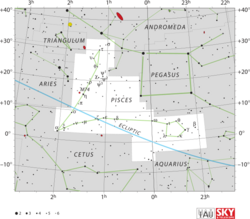Astronomy:Omega Piscium
| Observation data Equinox J2000.0]] (ICRS) | |
|---|---|
| Constellation | Pisces |
| Right ascension | 23h 59m 18.69064s[1] |
| Declination | +06° 51′ 47.9562″[1] |
| Apparent magnitude (V) | 4.01[2] |
| Characteristics | |
| Spectral type | F4 IV[3] or F4 V[4] |
| U−B color index | +0.07[2] |
| B−V color index | +0.42[2] |
| Astrometry | |
| Radial velocity (Rv) | +2.9±0.3[5] km/s |
| Proper motion (μ) | RA: +150.35[1] mas/yr Dec.: −112.12[1] mas/yr |
| Parallax (π) | 31.26 ± 0.15[1] mas |
| Distance | 104.3 ± 0.5 ly (32.0 ± 0.2 pc) |
| Absolute magnitude (MV) | +1.51[6] |
| Details | |
| ω Psc A | |
| Mass | 1.22[7] M☉ |
| Luminosity | 21[6] L☉ |
| Surface gravity (log g) | 3.74±0.14[7] cgs |
| Temperature | 6,641±226[7] K |
| Metallicity [Fe/H] | −0.09[8] dex |
| Rotational velocity (v sin i) | 40.3[9] km/s |
| Age | 1.337[7] Gyr |
| Other designations | |
| Database references | |
| SIMBAD | data |
Omega Piscium (Omega Psc, ω Piscium, ω Psc) is a star approximately 106 light years away from Earth, in the constellation Pisces. It has a spectral type of F4IV, meaning it is a subgiant/dwarf star, and it has a temperature of 6,600 kelvins. It may or may not be a close binary star system. Variations in its spectrum were once interpreted as giving it an orbital period of 2.16 days, but this claim was later debunked as false. It is 20 times brighter than the Sun and is 1.8 times greater in mass, if it is a single star.[11]
It is part of the drawn asterism in classic and modern renderings as the start of the tail, east of the Circlet of Pisces,[11] a near-circle which forms all but the tail (the head and body) of the western (fatter) "fish" in the constellation of two fishes.[12]
Right ascension
Considering stars with Flamsteed numbers, Greek letters, and proper names, Omega Piscium at J2000 (namely in the year 2000) was the named star with the highest right ascension (akin to terrestrial longitude). Due to the 26,000-year movement of the Earth's axis tracing an imperfect circle (axial precession), it has since increased to just beyond 0 hours, which it reached in J2013.
At the cusp of sunrise on the March Equinox in the present era the circlet appears just above the sunrise being the westernmost part of the asterism; the easternmost parts can be most easily seen after sunset, just above the Sun on a maximal horizon, such as the sea. A month later the progress of the Earth around the plane of the ecliptic (its orbit) by a mean 2 hours of Right Ascension (18° of orbit) means that the sun rises and sets in an outer part of Aries bordering Cetus.
Naming
- ω Piscium is the star's Bayer designation.
- In the catalogue of stars in the Calendarium of Al Achsasi al Mouakket, this star was designated Dzaneb al Samkat, which was translated into Latin as Cauda Piscis, meaning the tail of fish.[13]
- In Chinese, 霹靂 (Pī Lì), meaning Thunderbolt, refers to an asterism consisting of refers to an asterism consisting of ω Piscium, β Piscium, γ Piscium, θ Piscium and ι Piscium. Consequently, the Chinese name for ω Piscium itself is 霹靂五 (Pī Lì wu, English: the Fifth Star of Thunderbolt.)[14]
References
- ↑ 1.0 1.1 1.2 1.3 1.4 van Leeuwen, F. (2007), "Validation of the new Hipparcos reduction", Astronomy and Astrophysics 474 (2): 653–664, doi:10.1051/0004-6361:20078357, Bibcode: 2007A&A...474..653V.
- ↑ 2.0 2.1 2.2 Johnson, H. L. et al. (1966), "UBVRIJKL photometry of the bright stars", Communications of the Lunar and Planetary Laboratory 4 (99): 99, Bibcode: 1966CoLPL...4...99J.
- ↑ Griffin, R. F.; Redman, R. O. (1960), "Photoelectric measurements of the λ4200 A CN band and the G band in G8-K5 spectra", Monthly Notices of the Royal Astronomical Society 120 (4): 287–316, doi:10.1093/mnras/120.4.287, Bibcode: 1960MNRAS.120..287G.
- ↑ Abt, Helmut A. (2009), "MK Classifications of Spectroscopic Binaries", The Astrophysical Journal Supplement 180 (1): 117–18, doi:10.1088/0067-0049/180/1/117, Bibcode: 2009ApJS..180..117A.
- ↑ Gontcharov, G. A. (November 2006), "Pulkovo Compilation of Radial Velocities for 35495 Hipparcos stars in a common system", Astronomy Letters 32 (11): 759–771, doi:10.1134/S1063773706110065, Bibcode: 2006AstL...32..759G.
- ↑ 6.0 6.1 Anderson, E.; Francis, Ch. (2012), "XHIP: An extended hipparcos compilation", Astronomy Letters 38 (5): 331, doi:10.1134/S1063773712050015, Bibcode: 2012AstL...38..331A.
- ↑ 7.0 7.1 7.2 7.3 David, Trevor J.; Hillenbrand, Lynne A. (2015), "The Ages of Early-Type Stars: Strömgren Photometric Methods Calibrated, Validated, Tested, and Applied to Hosts and Prospective Hosts of Directly Imaged Exoplanets", The Astrophysical Journal 804 (2): 146, doi:10.1088/0004-637X/804/2/146, Bibcode: 2015ApJ...804..146D.
- ↑ Pace, G. (March 2013), "Chromospheric activity as age indicator. An L-shaped chromospheric-activity versus age diagram", Astronomy & Astrophysics 551: 4, doi:10.1051/0004-6361/201220364, L8, Bibcode: 2013A&A...551L...8P.
- ↑ Schröder, C.; Reiners, Ansgar; Schmitt, Jürgen H. M. M. (January 2009), "Ca II HK emission in rapidly rotating stars. Evidence for an onset of the solar-type dynamo", Astronomy and Astrophysics 493 (3): 1099–1107, doi:10.1051/0004-6361:200810377, Bibcode: 2009A&A...493.1099S, http://goedoc.uni-goettingen.de/goescholar/bitstream/handle/1/9690/aa10377-08.pdf?sequence=2[yes|permanent dead link|dead link}}]
- ↑ "ome Psc". SIMBAD. Centre de données astronomiques de Strasbourg. http://simbad.u-strasbg.fr/simbad/sim-basic?Ident=ome+Psc.
- ↑ 11.0 11.1 "Omega Psc". http://www.astro.uiuc.edu/~kaler/sow/omegapsc.html.
- ↑ "Western Pisces". http://www.astro.uiuc.edu/~kaler/sow/psc-w-p.html.
- ↑ Knobel, E. B. (June 1895). "Al Achsasi Al Mouakket, on a catalogue of stars in the Calendarium of Mohammad Al Achsasi Al Mouakket". Monthly Notices of the Royal Astronomical Society 55: 430. doi:10.1093/mnras/55.8.429. Bibcode: 1895MNRAS..55..429K.
- ↑ (in Chinese) AEEA (Activities of Exhibition and Education in Astronomy) 天文教育資訊網 2006 年 7 月 8 日
 |


